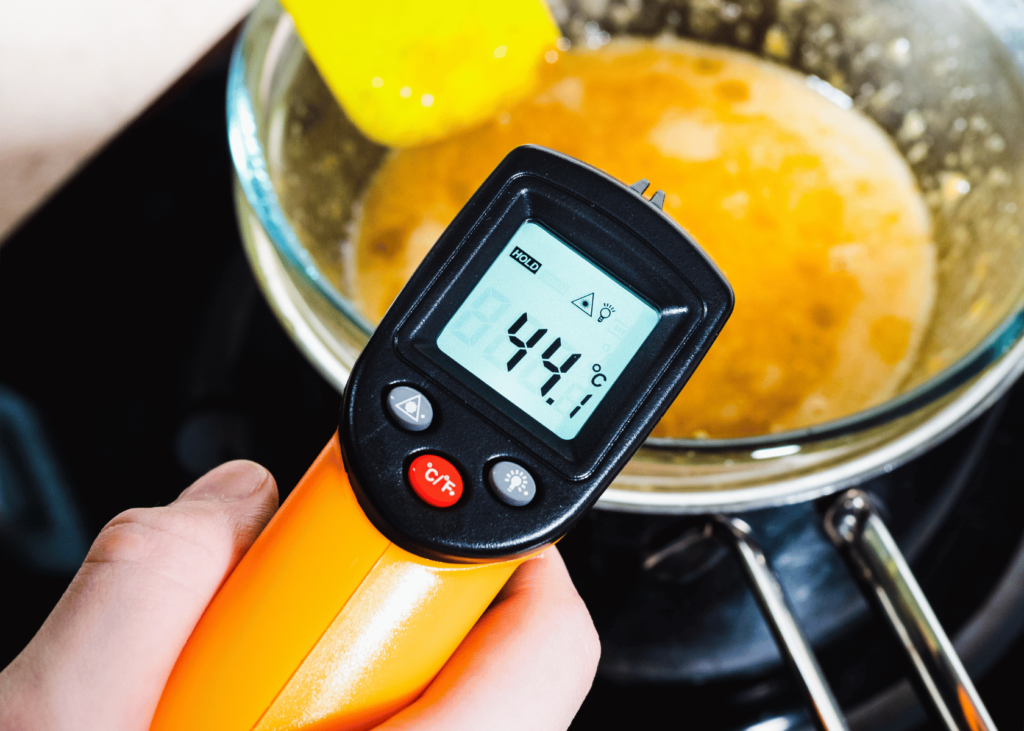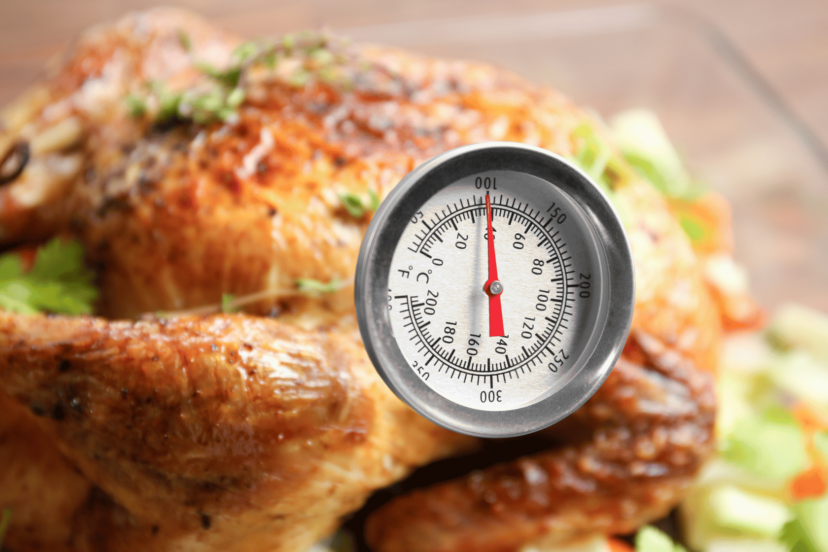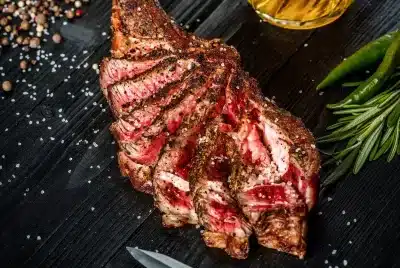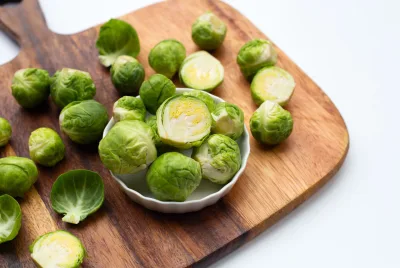Can You Use a Meat Thermometer for Candy?
Ever wondered if you can use a meat thermometer for candy making? Due to their differences in temperature measurements, this is not typically recommended. This article will guide you through why these two kitchen tools aren’t interchangeable and suggest alternatives when a candy thermometer isn’t at hand.
So, let’s dive into the sweet science of thermometers!
Table of Contents
Key Takeaways
- Meat thermometers are not recommended for candy making due to safety concerns, accuracy issues, and temperature range limitations.
- Using a meat thermometer instead of a candy thermometer can lead to inaccurate temperature readings and potential safety hazards.
- Candy thermometers are specifically designed for precise temperature control in candy making. They have features like long probes, easy-to-read displays, and helpful indicators for different stages of candy preparation.
- Alternatives to using a dedicated candy thermometer include the water test method and digital instant-read thermometers. However, these may not provide as precise or accurate results as using a candy thermometer.
The Difference Between a Meat Thermometer and a Candy Thermometer
Understanding the distinction between these two kitchen tools is vital for culinary precision. A candy thermometer, often called a sugar or confectionery thermometer. It works specifically for measuring incredibly high temperatures typically required in candy making.
This type of culinary device has a higher heat range compared to meat thermometers. Thus, it allows accurate temperature control necessary for creating delectable treats.
On the other hand, a meat thermometer’s purpose lies within setting perfect roasts and steaks. It delivers precise readings predominantly on lower ranges tailored toward cooking meat dishes safely and deliciously.
Yet when it comes to temperature probe functionality in candy-making scenarios, using a meat thermometer can lead to inaccurate results. This is due to its limitations related to higher heat measurement rendering them widely useless in this capacity.
Can You Use a Meat Thermometer for Candy?
A meat thermometer for candy is not a good option due to safety concerns, accuracy issues, and limitations of temperature range.
Safety concerns
Using a meat thermometer instead of a candy thermometer for making candy can pose several safety concerns. Meat thermometers are not suitable for high-temperature cooking applications like candy-making. Moreover, they may not provide accurate temperature readings for this purpose.
The temperatures required for cooking candies are much higher than what meat thermometers are typically calibrated for, which can lead to inaccurate results.
Moreover, using a meat thermometer in hot sugar syrup or other candy mixtures increases the risk of burns or injury. Meat thermometers usually have longer probes that may not be ideal for measuring the temperature accurately in small quantities of liquid or molten sugar.
Accuracy issues
Candy making requires precision when it comes to temperature control, and this is where the accuracy of a candy thermometer becomes crucial. Using a meat thermometer for candy can pose significant accuracy issues.
Meat thermometers are good to measure lower temperatures compared to candy thermometers, which have a wider temperature range specifically calibrated for making candies. This means that using a meat thermometer may not provide accurate readings needed for successful candy making.
Accuracy is key in achieving the desired texture and consistency of candies. Hence, the best bet is to use a dedicated candy thermometer instead.
Temperature range limitations
Meat thermometers have temperature range limitations that make them unsuitable for measuring candy temperatures. Candy making requires precise temperature control, often reaching high temperatures above what meat thermometers can handle.
Meat thermometers typically measure temperatures up to 200-220 degrees Fahrenheit (93-104 degrees Celsius), while candy making may require temperatures as high as 300 degrees Fahrenheit (149 degrees Celsius) or more.
Using a meat thermometer in place of a candy thermometer can result in inaccurate readings and potential safety hazards due to the lack of heat resistance and limited temperature range of meat thermometers.
Why It’s Recommended to Use a Candy Thermometer for Candy Making

Using a candy thermometer for candy making is highly recommended due to its specific features, accurate temperature readings, and ease of use – ensuring perfect candies every time.
Specific features and design for candy making
Candy thermometers are specifically designed with features and a design that cater to the unique requirements of candy making. These thermometers typically have a long probe or stem, allowing you to easily insert it into deep pots or pans without getting too close to the hot liquid sugar.
They often come with a clip or hook on the back, which can be used to attach them securely onto the side of your pot while you cook.
Additionally, candy thermometers usually have large, easy-to-read temperature displays that provide accurate readings for precise temperature control. This is crucial in candy making since even slight variations in temperature can affect the texture and consistency of your candies.
Some candy thermometers also include helpful markers or indicators for specific candy stages such as soft ball, hard crack, and caramelizing.
Accurate temperature readings
Accurate temperature readings are crucial when making candy, as precise temperatures can greatly affect the outcome of your confectionery creations. Candy thermometers provide accurate readings within the range for candy-making, ensuring that you achieve the desired texture and consistency.
On the other hand, meat thermometers may not offer the same level of accuracy or be able to measure temperatures high enough for candy preparation. To ensure your candies turn out perfectly every time, it is highly recommended to use a dedicated candy thermometer.
Ease of use
Candy thermometers offer ease of use that meat thermometers can’t provide. They are specifically designed with features that make them user-friendly for candy making. Candy thermometers often come with a clip or hook to attach securely to the side of the pot, ensuring accurate temperature readings without constant holding.
They also have clearly marked temperature ranges and indicators to show different stages of candy making, such as soft ball, firm ball, and hard crack stages. This makes it easier for home cooks and professionals alike to achieve the desired consistency and texture in their candies.
With a candy thermometer, you can simply monitor the temperature while focusing on other aspects of your recipe without worrying about overcooking or burning your candy mixture.
Alternatives to a Candy Thermometer for Candy Making
There are a few alternatives to using a candy thermometer for candy making, such as the water test method or using a digital instant-read thermometer.
Water test method
To determine the temperature of candy without a candy thermometer, you can use the water test method. This simple technique involves dropping a small amount of hot syrup into a bowl of cold water and observing its behavior. Here’s how it works:
- Fill a small bowl with cold water and set it aside.
- Begin heating your candy mixture on the stovetop until it reaches the desired temperature according to your recipe.
- Once you believe the syrup is close to the target temperature, carefully take a small spoonful (about ½ teaspoon) of the hot syrup and drop it into the cold water.
- Let the syrup sit in the water for a few seconds without stirring or disturbing it.
- Remove the cooled syrup from the water and examine its texture and consistency.
- Refer to a candy making guide or recipe to determine what stage your candy has reached based on its appearance in the water test.
- Thread Stage: The cooled syrup forms thin threads or strands that dissolve when touched.
- Soft Ball Stage: The cooled syrup forms a soft, pliable ball that flattens when squeezed between your fingers.
- Firm Ball Stage: The cooled syrup forms a firm, yet slightly pliable ball that holds its shape when squeezed.
- Hard Ball Stage: The cooled syrup forms a hard ball that retains its shape even after being squeezed firmly.
- Soft Crack Stage: The cooled syrup separates into threads that easily bend before breaking.
- Hard Crack Stage: The cooled syrup separates into brittle threads that snap easily when bent.
Use of a digital instant-read thermometer

A digital instant-read thermometer is a convenient alternative to a candy thermometer for making candy. These thermometers are designed to provide accurate temperature readings quickly and easily.
With their wide temperature range, they can measure the high temperatures required for candy making. Simply insert the probe into the mixture and within seconds, you’ll have an accurate reading.
This eliminates the need to constantly check the temperature manually and ensures precise results every time. Whether you’re a beginner or an experienced candy maker, using a digital instant-read thermometer can make your candy-making process much more efficient and successful.
Conclusion
In conclusion, using a meat thermometer for candy making is not recommended. While meat thermometers are great for cooking meats to perfection, they lack the specific features and temperature range necessary for accurate candy-making.
To ensure the best results and safety in your candy creations, it’s always best to invest in a dedicated candy thermometer. Happy candy making!
*We may earn a commission for the purchases made using our links. Please see our disclosure to learn more.




